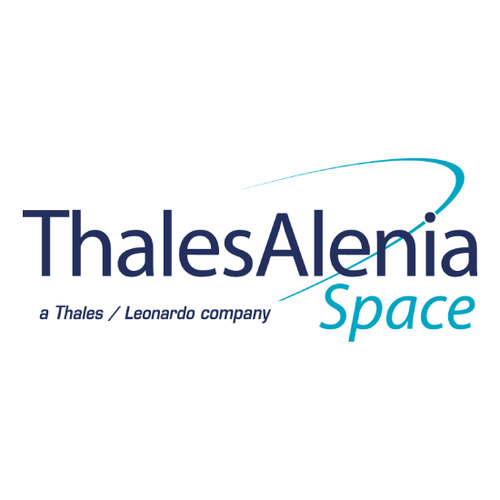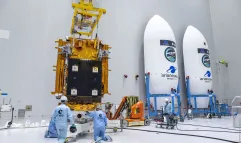At Thales Alenia Space, we take pride in showcasing what we do. So to celebrate our satellites we turned to talented artist Mathieu Persan. Here, we go behind the scenes to see how he produced this artwork spotlighting the singular features of our programs and telling the story of how they were put together with our customers.
Sentinel-1C keeping a watchful eye over Earth’s environment

Sentinel-1C © Mathieu Persan
In 2014, Europe sent into orbit Sentinel-1A, the first of 12 families of Earth-observation satellites destined for its Copernicus environmental monitoring program. At the time of writing, Sentinel-1C is the latest to have been successfully launched by a Vega-C vehicle from Europe’s spaceport in French Guiana.
Sentinel-1C will deliver radar imagery of Earth’s surface to underpin a broad range of Copernicus science services and applications. The new satellite will acquire images in all weathers, day and night. Its many missions include monitoring sea ice and the Arctic environment, detecting landslides, mapping forests, water resources and soils, and supporting natural disaster preparedness. Besides this, Sentinel-1C is the first in the Sentinel-1 series carrying an automatic identification system (AIS) that will make it highly valuable for maritime safety, helping to improve shipping traffic management, anticipate and avoid collisions at sea and keep track of ships in critical areas — a kind of multi-application environmental monitoring toolbox that greatly inspired our illustrator, Mathieu Persan.
Koreasat 6A: a symbol of national pride for South Korea

Koreasat 6A © Mathieu Persan
This communications satellite eagerly awaited by South Korea has a special distinguishing feature. Successfully launched on November 11, 2024, Koreasat 6 was built for Korean operator KT Sat to deliver TV and radio broadcast services from its geostationary orbit slot at 116° East, replacing Koreasat 6.
Besides its communications mission, Koreasat 6A will also play a key role enhancing the positioning accuracy and reliability of the Korea Augmentation Satellite System (KASS) thanks to its Satellite-Based Augmentation System (SBAS) payload. Comparable to Europe’s EGNOS system and operational since late 2023, KASS was also developed by Thales Alenia Space in partnership with national space agency the Korea Aerospace Research Institute (KARI).
Koreasat 6A services will complement the initial operational capability provided for KASS by the MEASAT-3D geostationary satellite, improving Global Navigation Satellite System (GNSS) positioning performance for many sectors, notably air navigation. Ultimately, these services will be extended to other applications like land transportation and location-based services (LBS).
Cygnus: station crews’ preferred resupply spacecraft

Cygnus © Mathieu Persan
Our teams can be proud of how far we have come as a supplier of pressurized space modules. Having already provided nearly 50% of the habitable volume of the International Space Station, we were selected to build three pressurized modules for the future Lunar Gateway cislunar outpost, and two for Axiom, the world’s first commercial space station. Drawing on the expertise acquired with the ISS, our engineers in Turin also build all of the pressurized cargo modules for Cygnus spacecraft, which resupply the station’s crews with food, water, fuel, spare parts, and science experiments twice a year. Two variants of Cygnus have been operated, one in “standard” configuration for its first flights, with a payload capacity of 2.75 metric tons and a useful volume of 18 cubic meters; and one in “enhanced” configuration, ferrying 3.75 metric tons of cargo with a useful volume 27 of cubic meters. Our engineers are now working on a new variant able to accommodate 5 metric tons of freight in a useful volume of 36 cubic meters! In total, Thales Alenia Space has built an unprecedented 25 cargo modules for prime contractor Northrop Grumman.
Did you know that Cygnus spacecraft are also something of a trendsetter, inspiring a leading fashion designer? The multilayer insulation that protects them from extreme temperature excursions in space caught the eye of House of Pierre Cardin, which created a stunning “satellite dress” using this original material.
Euclid shedding light on dark energy and dark matter

Euclid © Mathieu Persan
This marvel of technology launched in July 2023 from Cape Canaveral, Florida (USA) is the result of an ambitious mission conceived by the European Space Agency (ESA) to compile a cosmic atlas of the universe reaching as far back as 10 billion light-years.
Euclid is training its eyes on dark energy and dark matter in an effort to find out what’s driving the accelerated expansion of the universe. Combining visible and infrared instruments, it’s capable of surveying the skies in unrivaled depth, providing pictures at least four times sharper than anything obtained by ground-based telescopes.
Euclid’s unprecedented wealth of data is giving scientists new insights into these mysterious phenomena.
MTG-I1 marks the coming of a new generation of weather satellites

MTG-I1 © Mathieu Persan
MTG-I1 is the first imaging satellite in the Meteosat Third Generation (MTG) series. This ambitious program to improve weather forecasting for Europe and Africa will comprise six satellites in total: four imaging satellites and two atmospheric sounding satellites forming a constellation in geostationary orbit set to revolutionize modern weather forecasting.
In orbit since December 2022, MTG-I1 is the first in line.
The satellite’s new-generation Flexible Combined Imager (FCI) provides a global picture of Earth refreshed every 10 minutes, and a fast imaging mode capable of taking pictures of Europe every 2½ minutes — a new record!
SES-22 satellite built in double-quick time!

SES-22 © Mathieu Persan
Time now to look at the SES-22 geostationary communications satellite, represented by this stopwatch with 22 time divisions.
The visual conveys the race against time that Thales Alenia Space teams undertook to build and deliver the satellite in just 22 months.
Launched in 2022 and built in 22 months, the aptly named SES-22 satellite is today delivering direct TV and radio to millions of homes in North America.
EUTELSAT KONNECT VHTS: the record-breaking satellite

EUTELSAT KONNECT VHTS © Mathieu Persan
EUTELSAT KONNECT VHTS is a geostationary communications satellite launched on September 7, 2021.
Spanning a total of 45 meters with its solar panels fully deployed, EUTELSAT KONNECT VHTS really is an “outlier” too big even to fit into our visual! Standing 8.8 meters tall and weighing nearly 6½ metric tons in its final configuration, it’s the largest satellite ever built by Thales Alenia Space.
We’re running out of superlatives for our highest-capacity satellite yet, designed to bridge the digital divide in Europe by taking broadband Internet services to “notspots” underserved by terrestrial infrastructures.
Art and satellites: an unexpected and impactful combination!


